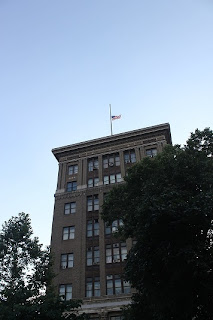It's hard to explain what's so scary about this place. It has a surprisingly walkable downtown with some interestingly rich architecture, but even with a concert, baseball game, and Cirque du Soleil, a few blocks from the waterfront the only souls that can be found are in cars...everywhere.
Perhaps that's what makes it so scary. Were it not for all the traffic, it felt like the second act of a zombie movie. With the exception of the undead factor, it's probably not far from reality. Even the worst parts of Philadelphia have active pedestrians, and even when they appear unsavory, seeing enough people on foot can make you feel safe. Lack of street life kills a city, and worse, kills safety. It's easy to drive passed a crime and not even notice, and just as easy for criminals to act when they know this.
Rutger's campus was a ghost town and that certainly didn't help. But beyond campus, City Hall, clean and iconic, was desolate on a Saturday afternoon. It's obvious that money has gone into improving the streetscape but it clearly hasn't convinced anyone Camden is a better place.
Those who live in the restored townhouses closer to the core and the RCA lofts near the water are fortressed in their homes, surrounded by gates with parking at their door.
What life could be found was on the river in the endless acres of tailgating, drunken teenagers, and police officers struggling to direct traffic through a city that decided to turn off it's traffic lights on the rare occasion that it would actually see traffic.
Locked down for the Thunderdome.
If you're on foot, you're left darting across traffic at your own risk, followed by a glare from an officer that says, "how dare you walk." It might be an apt accusation. The parking lots on the waterfront have a footprint the size of Society Hill.
It's unfortunate for the city, which hosts a collection of amazing architecture and an historic core with a wealth of potential.
New Jersey is an odd place, particularly it's major cities. The state shrugs a political disregard for its struggling urban spaces, taxing a dwindling working class into oblivion in lieu of its suburbs. Meanwhile most of those suburbs service major cities in other states.
That disregard is carried over in its citizens and visitors chucking beer cans into the Delaware River as police officers look on and laugh.
It's a lawless place.
Like Detroit and dying Rust Belt towns, Camden's fate is uncertain. It's riverfront attractions, Rutgers University, and Cooper Medical Center certainly help the city stay afloat. But as Philadelphia is learning, improving a city requires it to evolve, a feat that can't be met without new residents and a new mentality.
If those who reside in Camden continue to work and play in other cities and states, the city is nothing more than a poor suburb that happens to look like a city.
Suburbs are finally learning the lessons that our major cities spent the last decade tackling. Moving forward in some respects means turning back the clock. Parking lots and drivability produced successful suburbs like Cherry Hill and King of Prussia in the mid-1900s, but it's a dying and unsustainable infrastructure, one that much of New Jersey still clings to.
In a state attached to its mid-century nostalgia, it's hard to say if South Jersey will ever understand the dynamic infrastructure they have in Camden laying in wait.










No comments:
Post a Comment